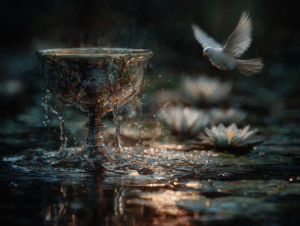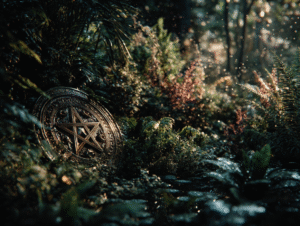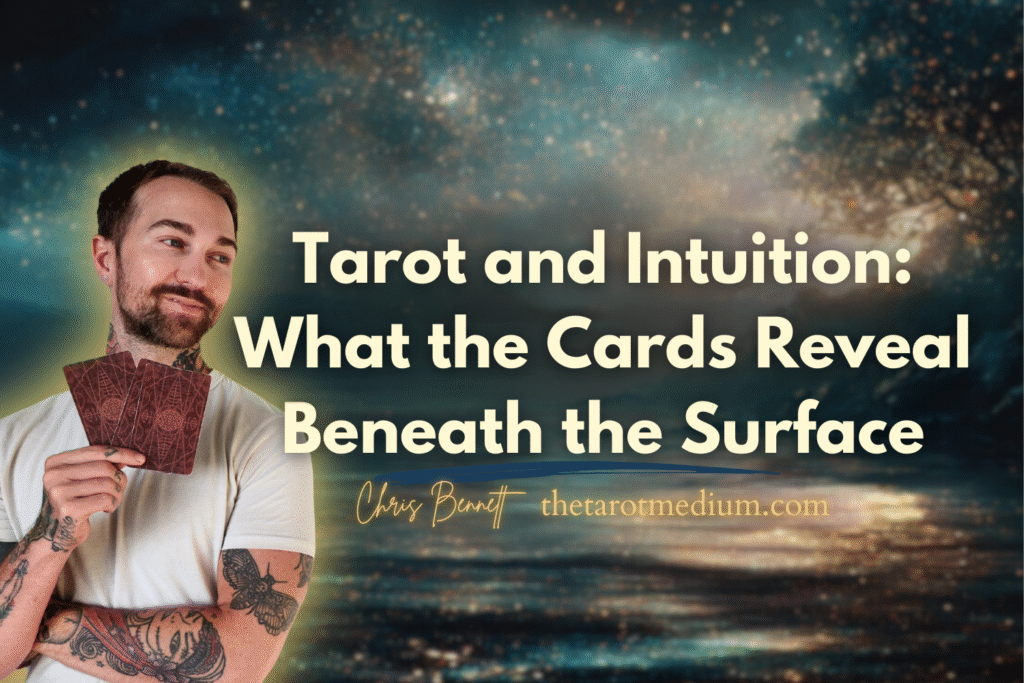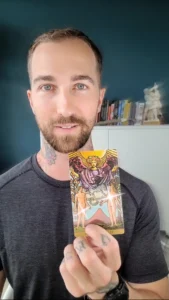Tarot and Intuition: Eight Timeless Ways the Cards Teach Us to Listen Within
Most people think tarot is about predicting the future, some dramatic peek into what’s waiting around the corner. The truth? Tarot isn’t about fortune-telling at all. It’s about tuning into your inner compass and learning to trust the quiet signals you already carry.
Maybe you’ve just bought your first deck and wonder if you’re “doing it right.”
Maybe you’ve been curious for years, secretly pulling cards but not sure if they mean anything.
Or maybe you’re not sure you even believe in tarot, yet you keep circling back because something in you wants to heighten intuition, cut through the noise, and feel more grounded in your choices.
Even skeptics find themselves surprised when a card stirs something they can’t explain, a memory, a truth, a gut feeling they hadn’t admitted yet. That’s the real power of tarot: not to hand you answers, but to help you discover you’ve had them all along.
Read until the end, because number one reveals why tarot has lasted centuries, and why it may just become the most practical tool you ever pick up.
8. Tarot Creates Space for Reflection, The Fool
Sometimes the bravest step toward intuition is the pause you take before moving forward.

The Fool is all about stepping into the unknown. That’s exactly what happens when you pull a tarot card: you pause, set down your to-do list, and dare to see what else might be stirring beneath the surface.
In that single act, you’ve shifted from passive routine into active awareness, and that shift is where intuition begins to take root.
When I work with The Fool, I notice how it softens my grip on control. Instead of demanding certainty, I’m invited to wonder.
That wondering, the pause between question and answer, is where intuition emerges.
Psychologists often describe intuition as a form of rapid, subconscious pattern recognition. But for it to work, the nervous system has to be calm enough to register subtle cues.
The Fool tarot card teaches that intuition begins the moment you pause and step into the unknown.
The Fool creates that opening. Neuroscience calls this “switching networks”: the brain shifts out of the overactive problem-solving mode and into noticing, a state where the smallest impressions suddenly matter.
Tarot works much like meditation in this way. Both give the nervous system a reset, lowering the volume of anxious thought so the quiet voice of intuition can be heard. For beginners learning tarot, The Fool becomes a guidepost: intuition doesn’t require proof, it requires willingness. Each card you draw is a leap, not into fortune-telling, but into presence.
And that’s why The Fool strengthens intuition: it teaches you to treat uncertainty not as a threat but as an invitation. Every time you draw a card, whether you’re brand new to tarot, curious about how it really works, or already deep in your practice, you’re making the same choice: presence over prediction, exploration over fear.
Tarot isn’t just a niche practice anymore, it’s finding its way into fashion, art, and mainstream culture. Vogue explores why tarot and oracle decks are experiencing a modern renaissance, and how this rise speaks to a collective hunger for meaning.
7. Tarot Uses Archetypes You Already Know, The Magician
Symbols unlock the subconscious, reminding you that your tools are already in hand

The Magician has all four suits on his table: the wand, the cup, the sword, and the pentacle. These are not random objects, they are archetypes that live within us, symbols of creativity, emotion, intellect, and material grounding.
Even if you’ve never studied tarot, your subconscious recognizes them. Archetypes are part of the collective psyche, what Carl Jung described as universal patterns of human experience.
They stir something familiar: the sense of having tools at your disposal, the question of whether you’re fully using them, or the realization that you’ve overlooked one.
Personally, when I work with the Magician card, it reminds me that intuition is not abstract, it’s activated when I bring together what I already carry.
The act of laying eyes on this card immediately provokes a subtle self-audit: Where am I directing my energy? Am I leading with thought, emotion, instinct, or resources? Am I balancing them, or leaning too heavily on one? That internal dialogue is intuition being exercised.
The Magician tarot card shows how intuition sharpens when you recognize the tools already in your hands.
From a psychological perspective, the Magician strengthens intuition because he embodies agency. He calls you to notice your inner resources and to act with intention. And intuition, when sharpened, is not about chasing elusive signs, it’s about the ability to recognize patterns, integrate knowledge from multiple channels, and trust the synthesis.
In this way, the Magician becomes more than an image on a card. He is the mirror that reflects your capacity to channel focus, harness potential, and turn vision into reality. For me, each time I encounter him, I’m reminded that intuition is not passive; it is a skill, one that strengthens every time I acknowledge the tools already laid out before me.
If you’re holding your first deck and wondering what to do next, you’re not alone. Vogue’s guide to tarot for beginners offers an accessible entry point, a perfect companion to your first curious pulls.
6. Tarot Helps Separate Intuition from Anxiety, The High Priestess
The quiet voice of intuition never shouts; it waits for you to notice it beneath the noise.

The High Priestess doesn’t rush, doesn’t panic, she just knows. Her presence is a reminder that intuition rarely shouts; it whispers. Anxiety, on the other hand, is noisy and insistent, full of “what ifs” and worst-case scenarios.
Psychology tells us that fear triggers the amygdala, flooding the body with urgency, while intuition draws from the subconscious, a vast storehouse of memory, emotion, and experience that surfaces as quiet certainty.
Pulling this card is an exercise in learning to distinguish between the two. When I sit with the High Priestess, I practice asking: Is this reaction coming from fear, or from knowing?
The difference is subtle, but it changes everything. With time, I’ve realized that intuition feels calm, even when it points me toward a difficult truth. Anxiety feels frantic, pushing me into reactivity.
Personally, I’ve made a habit of drawing one card each morning, and when the High Priestess appears, it feels like she’s inviting me to deepen that dialogue. Sometimes she validates the instinct I was already leaning toward; other times she challenges me to look beneath my first reaction.
This daily relationship with tarot has trained me to hear the distinction more clearly, not only when I’m reading cards, but in the decisions I make throughout the day.
The High Priestess tarot card embodies the difference between intuition and anxiety, silence reveals truth.
That’s how the High Priestess strengthens intuition: she teaches us that clarity doesn’t arrive in a blaze of certainty, but in the quiet confidence of knowing which voice to trust.
Tarot isn’t about memorizing meanings; it’s about learning to listen. The Good Trade’s piece on how to read tarot breaks down the art of creating dialogue with the cards instead of chasing rigid definitions.
5. Tarot Reveals Blind Spots, Ace of Wands
Every spark has a shadow, intuition sharpens when you see what you’ve been overlooking.

The Ace of Wands is pure ignition, the creative fire that can illuminate possibility or consume everything in its path. It’s a card that doesn’t whisper; it demands attention.
Whenever this card shows up for me, it’s less about predicting a new beginning and more about asking the harder question: where is my energy going, and is it actually serving me?
On the surface, the Ace of Wands feels exhilarating, but that intensity also uncovers blind spots.
Psychologically, this speaks to the concept of attentional bias, our tendency to over-invest in what excites us, while overlooking what quietly drains us. In my own life, I’ve noticed that when this card appears, it often points to projects or commitments I’ve taken on impulsively.
What seemed like inspiration at first can quickly become distraction. Intuition sharpens when I pause to notice: is this spark lighting my way forward, or burning me out from within?
This is how tarot strengthens intuition: it trains us to observe where our energy is leaking. For me, it’s often the subtle overcommitments, the things I say “yes” to without fully checking in with myself. The Ace of Wands becomes a mirror, showing that raw passion must be directed with clarity. Just as psychologists note that awareness of blind spots is the first step toward behavioral change, this card reminds me that the act of noticing is itself an intuitive breakthrough.
Tarot doesn’t just tell you to follow your spark; it challenges you to refine it. The Ace of Wands teaches that inspiration without intention is scattered energy, but when guided, it becomes intuition in motion.
Your cards don’t exist in isolation, they move with the cosmos. See how tarot and astrology connect to give even richer context to your intuition.
4. Tarot Engages the Nervous System, Ace of Cups
When your body feels safe, your heart speaks clearly, the cards give space for that clarity

The Ace of Cups is a vessel that overflows, not with predictions, but with emotional truth. When I sit with this card, I notice how my body reacts before my mind does.
The flowing water, the open bowl, the invitation to receive, these images regulate the nervous system in subtle ways. They slow the pulse, soften the breath, and create the kind of calm where intuition can finally be distinguished from mental noise.
Psychologically, this matters because our intuition is often drowned out by states of stress.
The nervous system in fight-or-flight is too busy scanning for danger to notice inner guidance. But when you look at the Ace of Cups and allow yourself to feel its openness, you’re practicing nervous system regulation, the same state in which intuition is most accessible.
For me, this card has often acted as a mirror for emotions I was reluctant to name. I’ve pulled it on days when I thought I was angry, only to realize I was exhausted. Or when I believed I was fine, only to acknowledge I was quietly grieving. That recognition itself is intuition at work. It’s the body whispering what the mind refuses to admit.
The Ace of Cups teaches that intuition isn’t just mystical, it’s embodied. It reminds us that when the heart is full, when the body feels safe, we hear ourselves more clearly. That clarity becomes the reset: a return to honesty, presence, and emotional alignment.
True reading isn’t performance, it’s presence. The Willow Path Tarot shares why intuition is the cornerstone of tarot practice — a reminder that every card becomes clearer when you trust your first impression.
3. Tarot Builds Trust Through Pattern Recognition, Ace of Pentacles
Intuition isn’t random; it grows like a seed, watered each time you show up to the cards.

The Ace of Pentacles is the seed of something solid, a reminder that growth doesn’t happen overnight but through consistent tending.
Intuition develops in the same way: what begins as a fleeting impression can feel uncertain at first, almost dismissible. But when you give it space and attention, it takes root.
The Ace of Pentacles has taught me patience in trusting my own inner signals.
Early on, I would second-guess my impressions, wondering if I was imagining them. But by drawing a single card each day and journaling my first response, I began to notice patterns. A phrase I had scribbled weeks earlier would resurface in life’s unfolding circumstances, and I’d realize: that was intuition speaking the whole time.
Psychologically, this mirrors the process of pattern recognition. Our brains are wired to detect repetition and meaning, but when we’re distracted, those signals get lost. Tarot provides a container, a daily point of focus where those subtle impressions can be captured before they vanish. The act of writing them down anchors the intuitive process in memory, giving you evidence to return to later.
Over time, those daily Fool, Magician, or Ace of Cups pulls transform into a living relationship with the deck. The Ace of Pentacles reminds us that intuition is not a lightning strike but a cultivated garden. Each entry in your journal is a seed, and every time you return, you’re affirming: intuition grows stronger when I honor it.
Tarot isn’t just symbolic art, it can be a map for decision-making in everyday life. Here’s how tarot can guide your choices and help you make life-changing decisions.
2. Tarot Strengthens Empathy, Ace of Swords
Listening with clarity sharpens intuition, just as the sword cuts through the clouds.

The Ace of Swords has always stood out to me as a symbol of piercing truth, that clean moment when fog lifts and something undeniable comes into focus.
Working with this card has taught me that clarity isn’t just about knowing the answer; it’s about creating the space for truth to emerge.
When I read tarot for others, the Ace of Swords reminds me to quiet my own assumptions. Instead of filling the silence with what I think I know, I listen, to tone, to pauses, to the weight of words left unsaid.
Psychology calls this attunement, the process of noticing subtle cues that reveal far more than surface-level conversation ever could.
The Ace of Swords tarot card connects clarity, empathy, and intuition, teaching us to listen with precision.
Over time, I’ve learned that empathy itself is an intuitive act. By practicing it, the blade of intuition becomes sharper, more precise.
This card also highlights an important paradox: clarity often comes from restraint. The Ace of Swords doesn’t just cut through confusion; it teaches discernment, when to speak, when to wait, when to let the unspoken rise into awareness on its own.
In that way, the card becomes a daily practice in intuition, showing me that sometimes the most powerful insight comes not from rushing to declare what I see, but from allowing space for the truth to reveal itself.
At the core of tarot is a simple truth: intuition is only as strong as your willingness to honor it. Bright Space Coaching offers an insightful reflection on how to trust your intuition, wisdom that applies both with and without the cards.
1. Tarot Reminds You Intuition Is Already Yours, The World
The circle closes not with answers outside you, but with recognizing the wisdom within.

The World is the card of wholeness and integration, the closing of a cycle and the reminder that nothing essential is missing.
In my own practice, I’ve learned that The World isn’t about arrival in the way we usually think, it’s not the finish line. Instead, it’s the realization that the wisdom I was seeking was within me all along.
Pulling this card has often stopped me in my tracks, not with drama but with a quiet affirmation: you already know, you already are, you already have enough.
Psychologically, this mirrors what researchers describe as self-referential resonance, the way an image, phrase, or symbol can awaken recognition deep in the subconscious.
The World tarot card affirms that intuition is already yours, wholeness comes from recognizing inner wisdom.
That flicker of recognition is intuition at work. It’s not an external voice delivering answers but your own inner landscape reflecting back through the archetype. The World embodies that reflection in its most complete form, a mirror reminding you that intuition doesn’t arrive from the outside. It’s the circle closing back toward the self.
For anyone exploring tarot, whether as a beginner learning the language of the cards or as someone seeking a more accurate, embodied sense of guidance, The World serves as a final affirmation. Tarot doesn’t manufacture intuition, it strengthens it by returning you to what has always been present: your own inner compass.
If you’re new to the cards and wondering how to begin, you don’t need to memorize every meaning. This guide on how to read tarot cards for beginners shows you how to build a practice rooted in intuition rather than fear of “getting it wrong.”
Closing Guidance
Tarot is not about belief. It’s about practice, the daily discipline of listening inward. When I began pulling a single card each day, I realized it wasn’t about “predicting” my day ahead, but about creating a living dialogue with my intuition.
The Fool often reminded me to take small risks instead of defaulting to safety. The High Priestess, with her calm stillness, taught me to recognize when my reactions came from anxiety rather than knowing. The Ace of Pentacles grounded me, showing that intuition grows like any seed: through attention, consistency, and patience.
Psychologically, this ritual acts like a mirror for the subconscious. Each card serves as a prompt for pattern recognition, the very process the brain uses to build intuition.
Over time, I learned to trust the first impressions, the fleeting images, and the subtle shifts in feeling. That quiet noticing began spilling into everyday life: the ability to sense when someone wasn’t saying the whole story, when an opportunity carried real weight, or when my own body was telling me to rest.
Intuition isn’t a rare gift. It’s a skill that can be strengthened, refined, and trusted. Tarot accelerates that process because it creates a symbolic framework that speaks directly to the subconscious.
Whether you’re seeking accurate tarot insights, exploring psychic development, or simply wanting to trust yourself more deeply, one card a day can change the way you move through the world.
The best tarot readings aren’t about prediction, they’re about transformation. Explore what makes the best tarot readings so deeply impactful and accurate.
In the end, tarot doesn’t point outside of you. Each card, whether it comforts or challenges, is guiding you back to yourself, to a place where intuition isn’t a whisper to doubt, but a voice you know you can trust. And that is where its true power lives.
If this sparked your curiosity and you’d like to know what a session actually feels like, read what to expect from a tarot or mediumship reading.
And if you’re ready to experience it for yourself, you can book your reading here.
This article is by Chris Bennett, a Canadian Psychic Medium and Tarot Reader ranked among the best in the world. For more than 20 years, Chris has dedicated his career to providing online readings exclusively, earning over 275 five-star reviews for his accuracy, compassion, and evidential style. Recognized internationally, he provides accurate tarot and mediumship readings for clients in Manchester, Dunedin, Toronto, Johannesburg, Sunshine Coast, Ottawa, Glasgow, Las Vegas, Ballarat, and Rotorua, reaching people across the United Kingdom, New Zealand, Canada, South Africa, Australia, and the United States.


